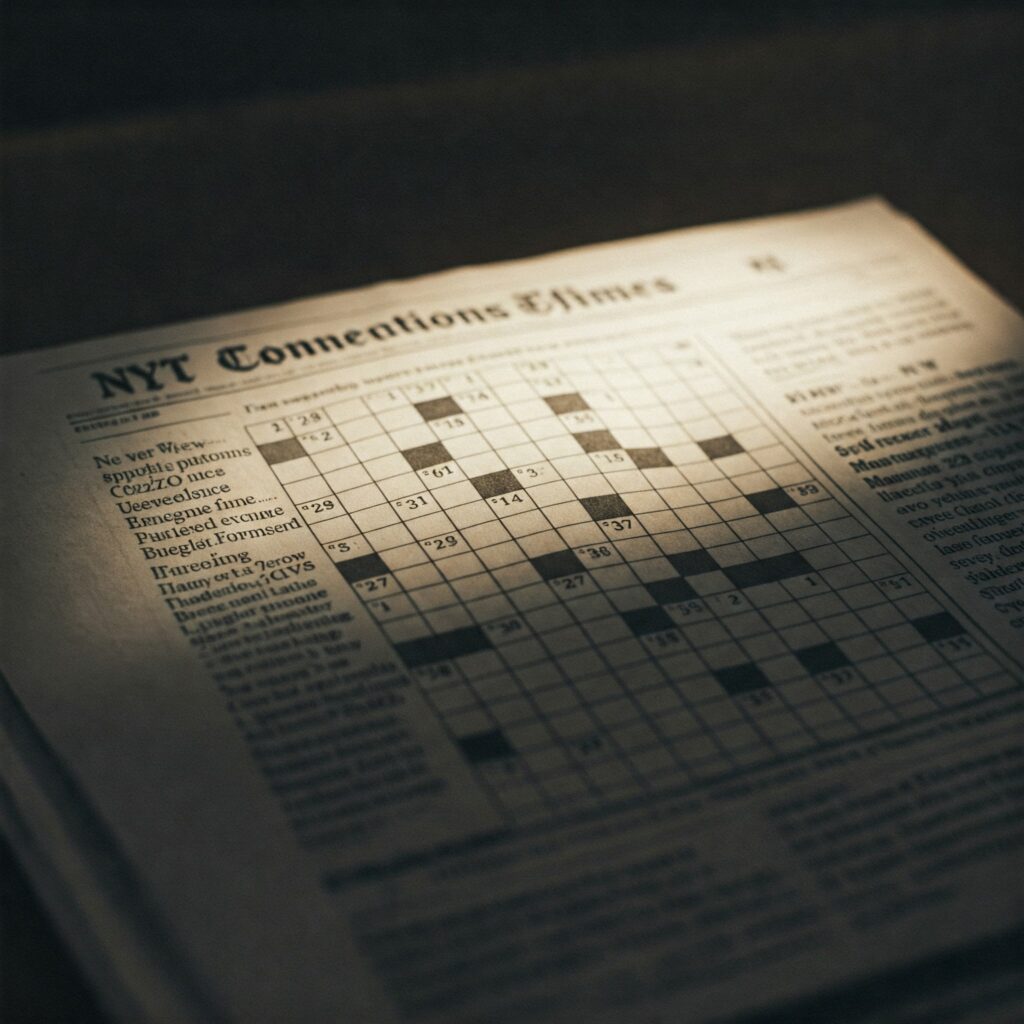Mastering NYT Connections Hint Strategies Secrets and Daily Puzzle Help
Introduction
The New York Times has long been at the forefront of challenging word and logic games. From the timeless Crossword to the internet-famous Wordle, the NYT has successfully captivated puzzle enthusiasts worldwide. One of its latest additions, the “Connections” game, brings a fresh twist to wordplay, blending categorization, lateral thinking, and deductive logic. Each day, players are presented with a 4×4 grid containing 16 seemingly random words. The challenge? Group them into four categories of four words each. As simple as it sounds, it can become a perplexing mental maze.
Hints have emerged as a vital resource for tackling the daily Connections puzzle, especially on days when the categories are deceptively tricky. Players who regularly engage with NYT Connections know that a clever hint can mean the difference between a triumphant victory and a frustrating defeat. This article dives deep into how to use these hints effectively, where to find them, and strategies to maximize your success while still enjoying the game’s core challenge. Whether you’re a beginner or a seasoned player, understanding the art of interpreting hints will elevate your Connections experience.
What Is NYT Connections
Origins and Concept
NYT Connections debuted as a beta puzzle in the New York Times Games suite, offering a fresh approach to mental exercises. Instead of focusing on a single word or trivia knowledge, Connections challenges players to identify underlying relationships among words. Designed to promote associative thinking and mental agility, it’s quickly become a staple for puzzle lovers. The game’s simplicity hides a deep complexity, making it both accessible and endlessly engaging.
Each day presents a new puzzle composed of 16 words. The goal is to group them into four related sets. These sets might be anything from types of pasta to film genres, internet slang, or historical events. What makes the game uniquely engaging is its reliance on flexible thinking. The creators often introduce red herrings—words that seem like they belong together but actually don’t—to throw off players.
Game Mechanics and Color Difficulty
The gameplay starts with a 4×4 word grid. Users must group the words into four categories, which become progressively more difficult: yellow (easiest), green, blue, and purple (hardest). Players are allowed up to four incorrect guesses, adding pressure and strategic depth to each selection. Once a group is successfully found, the words disappear, narrowing down the field and increasing the clarity for subsequent groupings.
The gradual increase in difficulty by color not only adds a layer of complexity but also helps guide the player’s progress. Recognizing and leveraging this color system can assist in identifying easier matches first, giving confidence to tackle the more elusive categories.
The Role of Hints in NYT Connections
How Hints Enhance Gameplay
Hints can transform the NYT Connections experience, especially when players hit a mental block. Instead of outright giving away answers, a good hint offers just enough information to jog the mind. These hints might suggest a broad category (e.g., “types of cheeses”) or offer a clue involving initials or synonyms. For many, a well-timed hint keeps the challenge alive without spoiling the fun.
Hints are particularly helpful for newcomers who are unfamiliar with the puzzle’s logic and expectations. For seasoned solvers, hints offer a way to speed up gameplay or work through especially difficult groupings. They enhance comprehension of category structure, improve future play, and reinforce learning through subtle prompting.
Types of Hints Available
Players can find hints from various sources. While NYT doesn’t always provide official hints, the player community has stepped up. Platforms like Reddit, Twitter (now X), and Discord groups offer daily discussions and clue-sharing. Some popular puzzle websites also publish non-spoiler hints that preserve the puzzle’s integrity while helping stuck players regain momentum.
Hints range from simple category labels to more cryptic nudges that encourage players to think abstractly. For example, a hint might be “Think of classic board games” or “These share a connection with popular streaming platforms.” The effectiveness of a hint depends on its subtlety and the player’s interpretive ability.
Ethical Use of Hints

While some purists argue that using hints diminishes the puzzle’s challenge, many players view them as educational tools. The use of hints is akin to getting help in a crossword or using a thesaurus—it doesn’t necessarily mean cheating. The key lies in using hints judiciously to support learning and maintain enjoyment.
Players often develop their own code of conduct. Some allow themselves a single hint per day, while others only consult hints after exhausting their four mistakes. Whatever your style, the ethical use of hints ensures you keep improving without losing the satisfaction of discovery.
Daily NYT Connections Hint Breakdown
How Daily Hints Are Structured
Hints often follow a recognizable format. Common approaches include listing the theme of one group without naming the words or offering the first letters of each group’s words. Others might reference pop culture or give vague clues that require further decoding. These structured hints preserve the integrity of the puzzle while giving the brain a nudge in the right direction.
Online communities do a great job of presenting hints in tiers: easy, moderate, and hard. This lets players decide how much assistance they want. For instance, an “easy hint” might directly reference the theme, while a “hard hint” might involve wordplay or a pun.
Interpreting and Applying Hints
The key to using hints effectively lies in understanding what the hint implies. If a hint says, “Think Italian cuisine,” your brain immediately filters words like “Rigatoni,” “Pesto,” or “Lasagna.” This directional approach helps narrow down options and often sparks an “aha!” moment.
Players benefit most from using hints after identifying one or two likely matches but struggling to complete a group. This strategy keeps the puzzle engaging while reducing frustration. By cross-referencing the hint with known words, players can more easily discard red herrings and focus on real connections.
Example Walkthroughs
Imagine a Connections puzzle with the following words: “Mario, Luigi, Toad, Peach, Saturn, Mars, Jupiter, Venus.” A hint like “Fictional Characters” quickly leads to grouping the Super Mario characters, while a secondary hint like “Planets” clarifies the second group. Step-by-step hint usage like this keeps gameplay engaging and educational.
These walkthroughs, often shared on puzzle blogs and forums, offer new players insight into effective thought processes. By learning how others interpret hints, players can refine their strategies and increase success rates over time.
Winning Strategies Without Relying on Hints
Pattern Recognition Tips
A crucial skill in mastering NYT Connections is recognizing word patterns. Are there multiple words that are names? Are there items that belong to a kitchen, a map, or a TV show? Starting with basic categorization—like nouns, proper names, or verbs—can help spot initial groupings.
Players should also look for duplicate roles. For example, if two words are clearly types of birds, there’s a good chance two more exist in the list. Visual scanning and mental cross-referencing become vital tools when hints aren’t available.
Category Guessing Frameworks
To reduce randomness, build mental templates of common Connections categories. Think of colors, emotions, animals, countries, tech brands, or sports. Often, the daily puzzle includes at least one familiar set. Spotting these early gives confidence to break down more abstract groupings.
Red herrings make the puzzle especially challenging. A word like “Apple” could refer to a fruit or a tech company. Always cross-check context and consider multiple interpretations before committing to a group.
Time-Saving and Scoring Techniques
Start with obvious groups. Once the yellow or green group is cleared, the remaining field becomes easier to manage. Use process of elimination to reduce possibilities. Also, avoid random guessing—you only get four chances. Instead, verify potential groups by testing combinations logically.
If you’re stumped, take a short break and return later with a fresh mind. Many players solve Connections faster this way, catching patterns they initially missed. Mastering the game is less about rushing and more about patience and observation.
Community & Tools for NYT Connections Enthusiasts
Online Forums and Groups
Reddit communities like r/NYTConnections and daily Twitter threads are gold mines for hints, strategies, and shared triumphs. Players post screenshots, celebrate perfect games, and dissect tricky categories together.
These platforms foster a supportive environment where veterans mentor new players. The sense of camaraderie and collaboration adds a social layer to what is otherwise a solo activity.
Companion Apps and Tools
Several third-party tools and mobile apps now exist to archive puzzles, track your progress, and even suggest practice puzzles. These apps often include a “hint mode” that simulates the clue-giving without outright solving.
Players who wish to practice can use past puzzles, available through NYT’s archive or through fan-made databases. This helps improve pattern recognition and category recall over time.
Sharing, Competing, and Collaborating
A big part of the fun lies in sharing your results. Many post their scores on social media, comparing completion times or celebrating streaks. Friendly competition and real-time collaboration (especially via group chats) make the daily puzzle more interactive.
Even families are getting involved. Some play as a group over breakfast, using hints together and bonding over shared brainpower. Whether competitive or casual, the social component enhances the Connections experience.
Conclusion
NYT Connections is more than just a word game—it’s a daily mental workout that rewards curiosity, lateral thinking, and strategic insight. Hints serve as helpful tools to guide players through particularly tough puzzles, enriching rather than spoiling the experience. By using hints wisely, leveraging community resources, and sharpening pattern recognition, players can develop both skill and confidence.
Ultimately, the goal is not just to win but to enjoy the process of uncovering hidden relationships and strengthening cognitive flexibility. So next time you play, don’t hesitate to reach for a well-crafted hint—it might be the key to your next perfect game.
FAQs NYT Connections Hint
Where can I find the daily NYT Connections hint?
You can find hints on Reddit, Twitter/X, puzzle forums, and dedicated NYT puzzle blogs.
Are hints available directly from the New York Times?
No, NYT does not consistently provide official hints. Most hints come from the player community.
Do hints change throughout the day?
No, hints remain consistent per puzzle but may vary in interpretation by different players.
Can hints ruin the challenge of solving the puzzle?
Not if used carefully. Hints can support learning and reduce frustration without spoiling the puzzle.
is there a limit to how many hints I can use?
There’s no set limit, but many players self-regulate how many hints they consult.
Are third-party hint sources trustworthy?
Generally, yes—especially those from established puzzle communities with daily contributors.
How do hints differ for each difficulty color?
Hints for yellow groups are often more direct, while purple group hints may be abstract or obscure.
Can I create my own hints for others to use?
Absolutely! Many players enjoy crafting and sharing their own clever clues online.
What’s the best way to interpret a vague hint?
Focus on context and associations. Think broadly, then narrow down.
Do experienced players still use hints?
Yes. Even veterans occasionally consult hints, especially on difficult days.








Post Comment